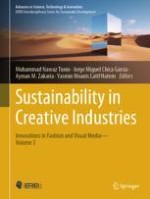2024 | OriginalPaper | Buchkapitel
Utilization of Vegetable Texture as an Alternative Tool for Printing Plates in Block Printing Techniques and Textile Motif Design
verfasst von : Ahda Yunia Sekar Fardhani
Erschienen in: Sustainability in Creative Industries
Verlag: Springer Nature Switzerland
Aktivieren Sie unsere intelligente Suche, um passende Fachinhalte oder Patente zu finden.
Wählen Sie Textabschnitte aus um mit Künstlicher Intelligenz passenden Patente zu finden. powered by
Markieren Sie Textabschnitte, um KI-gestützt weitere passende Inhalte zu finden. powered by
